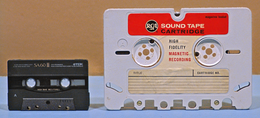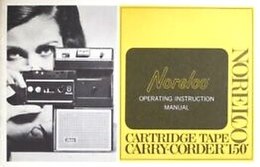 | |
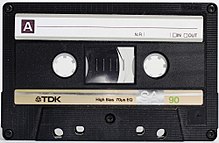 A TDK SA90 Type II Compact Cassette | |
| Media type | Magnetic tape cassette |
|---|---|
| Encoding | Analog signal, in four tracks |
| Capacity | Most commonly 30, 45, and 60 minutes per side (C60, C90, and C120)[1] |
| Read mechanism | Tape head |
| Write mechanism | Tape head |
| Developed by | Philips |
| Usage | Audio and data storage (succeeded by CD) |
| Extended from | Reel-to-reel audio tape recording |
| Extended to | Digital Compact Cassette |
| Released | August 1963 Lifespan: 1963-present |
The Compact Cassette, also commonly called a cassette tape,[2] audio cassette, or simply tape or cassette, is an analog magnetic tape recording format for audio recording and playback. Invented by Lou Ottens and his team at the Dutch company Philips, the Compact Cassette was released in August 1963.[3]
Compact Cassettes come in two forms, either containing content as a prerecorded cassette (Musicassette), or as a fully recordable "blank" cassette. Both forms have two sides and are reversible by the user.[4]
Although other tape cassette formats have also existed—for example the Microcassette—the generic term cassette tape is normally used to refer to the Compact Cassette because of its ubiquity.[5]
Compact Cassettes contain two miniature spools, between which the magnetically coated, polyester-type plastic film (magnetic tape) is passed and wound[6]—essentially miniaturizing reel-to-reel audio tape and enclosing it, with its reels, in a small case (cartridge)—hence "cassette".[7] These spools and their attendant parts are held inside a protective plastic shell which is 4 by 2.5 by 0.5 inches (10.2 cm × 6.35 cm × 1.27 cm) at its largest dimensions. The tape itself is commonly referred to as "eighth-inch" tape, supposedly 1⁄8 inch (0.125 in; 3.17 mm) wide, but actually slightly larger, at 0.15 inches (3.81 mm).[8] Two stereo pairs of tracks (four total) or two monaural audio tracks are available on the tape; one stereo pair or one monophonic track is played or recorded when the tape is moving in one direction and the second (pair) when moving in the other direction. This reversal is achieved either by manually flipping the cassette when the tape comes to an end, or by the reversal of tape movement, known as "auto-reverse", when the mechanism detects that the tape has ended.[9]
History
[edit]Precursors
[edit]After the Second World War, magnetic tape recording technology proliferated across the world. In the United States, Ampex, using equipment obtained in Germany as a starting point, began commercial production of tape recorders. First used in studios to record radio programs, tape recorders quickly found their way into schools and homes. By 1953, 1 million US homes had tape machines.[10]
In 1958, following four years of development, RCA Victor introduced the stereo, quarter-inch, reversible, reel-to-reel RCA tape cartridge.[11][12]
Introduction of mono version
[edit]In the early 1960s Philips Eindhoven tasked two different teams to design a tape cartridge for thinner and narrower tape compared to what was used in reel-to-reel tape recorders. By 1962, the Vienna division of Philips developed a single-hole cassette, adapted from its German described name Einloch-Kassette.[13]
Philips selected the two-spool cartridge as a winner and introduced the 2-track 2-direction mono version in Europe on 28 August 1963 at the Berlin Radio Show,[21] and in the United States (under the Norelco brand) in November 1964. The trademark name Compact Cassette came a year later. The team of Dutch and Belgian origin at Philips was led by the Dutch Lou Ottens in Hasselt, Belgium.[22][23][24]
Philips also offered a machine to play and record the cassettes, the Philips Typ EL 3300. An updated model, Typ EL 3301 was offered in the US in November 1964 as Norelco Carry-Corder 150. By 1966 over 250,000 recorders had been sold in the US alone and Japan soon became the major source of recorders. By 1968, 85 manufacturers had sold over 2.4 million players.[20][25] By the end of the 1960s, the cassette business was worth an estimated 150 million dollars.[20] By the early 1970s the compact cassette machines were outselling other types of tape machines by a large margin.[26]
Philips was competing with Telefunken and Grundig (with their DC International format [27]) in a race to establish its cassette tape as the worldwide standard, and it wanted support from Japanese electronics manufacturers.[28] Philips' Compact Cassette became dominant as a result of Sony pressuring Philips to license the format to them free of charge.[29]
In the early years sound quality was mediocre, but it improved dramatically by the early 1970s when it caught up with the quality of 8-track tape and kept improving.[30] The Compact Cassette went on to become a popular (and re-recordable) alternative to the 12-inch vinyl LP during the late 1970s.[30]
Stereo version
[edit]As with prerecorded reel-to-reel and 8-track, sales were slow to start, but picked up rapidly to tie with the 8-track before superseding it by the early '70s. By 1968, 85 manufacturers had sold over 2.4 million mono and stereo players.[20][25] By the end of the 1960s, the cassette business was worth an estimated 150 million dollars.[20] By the early 1970s the compact cassette machines were outselling other types of tape machines by a large margin.[31]
Popularity of music cassettes
[edit]The mass production of "blank" (not yet recorded) Compact Cassettes began in 1964 in Hanover, Germany.[20] Prerecorded music cassettes (also known as Music-Cassettes, and later just Musicassettes; M.C. for short) were launched in Europe in late 1965. The Mercury Record Company, a US affiliate of Philips, introduced M.C. to the US in July 1966. The initial offering consisted of 49 titles.[32]
However, the system had been designed initially for dictation and portable use, with the audio quality of early players not well suited for music. Some early models also had an unreliable mechanical design. In 1971, the Advent Corporation introduced their Model 201 tape deck that combined Dolby type B noise reduction and chromium(IV) oxide (CrO2) tape, with a commercial-grade tape transport mechanism supplied by the Wollensak camera division of 3M Corporation. This resulted in the format being taken more seriously for musical use, and started the era of high fidelity cassettes and players.[33]
British record labels began releasing compact cassettes in October 1967, and they exploded as a mass-market medium after the first Walkman, the TPS-L2, went on sale on 1 July 1979, as cassettes provided portability, which vinyl records could not. While portable radios and boom boxes had been around for some time, the Walkman was the first truly personal portable music player, one that not only allowed users to listen to music away from home, but to do so in private. According to the technology news website The Verge, "the world changed" on the day the TPS-L2 was released.[34][35][36] Stereo tape decks and boom boxes became some of the most highly sought-after consumer products of both decades, as the ability of users to take their music with them anywhere with ease[20] led to its popularity around the globe.[20][37]
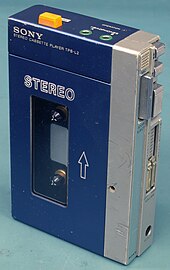
Like the transistor radio in the 1950s and 1960s, the portable CD player in the 1990s, and the MP3 player in the 2000s, the Walkman defined the portable music market for the decade of the '80s, with cassette sales overtaking those of LPs.[30][38] Total vinyl record sales remained higher well into the 1980s due to greater sales of singles, although cassette singles achieved popularity for a period in the 1990s.[38] Another barrier to cassettes overtaking vinyl in sales was shoplifting; compact cassettes were small enough that a thief could easily place one inside a pocket and walk out of a shop without being noticed. To prevent this, retailers in the US would place cassettes inside oversized "spaghetti box" containers or locked display cases, either of which would significantly inhibit browsing, thus reducing cassette sales.[39]
During the early 1980s some record labels sought to solve this problem by introducing new, larger packages for cassettes which would allow them to be displayed alongside vinyl records and compact discs, or giving them a further market advantage over vinyl by adding bonus tracks.[39] Willem Andriessen wrote that the development in technology allowed "hardware designers to discover and satisfy one of the collective desires of human beings all over the world, independent of region, climate, religion, culture, race, sex, age and education: the desire to enjoy music at any time, at any place, in any desired sound quality and almost at any wanted price".[40] Critic Robert Palmer, writing in The New York Times in 1981, cited the proliferation of personal stereos as well as extra tracks not available on LP as reasons for the surge in popularity of cassettes.[41]
Cassettes' ability to allow users to record content in public also led to a boom in bootleg cassettes made at live shows in the 1980s.[42] The Walkman dominated the decade, selling up to 350 million units. So synonymous did the name "Walkman" become with all portable music players—with a German dictionary at one point defining the term as such without reference to Sony—that the Austrian Supreme Court ruled in 2002 that Sony, which had not sought to have the publisher of that dictionary retract that definition, could not prevent other companies from using that name, as it had now become genericized.[43][44][45] As a result of this, a number of Sony's competitors produced their own version of the Walkman. Others made their own branded tape players, like JVC, Panasonic, Sharp, and Aiwa, the second-largest producer of the devices.[46]
Between 1985, when cassettes overtook vinyl, and 1992, when they were overtaken by CDs[36] (introduced in 1983 as a format that offered greater storage capacity and more accurate sound),[47] the cassette tape was the most popular format in the United States[36] and the UK. Record labels experimented with innovative packaging designs. A designer during the era explained: "There was so much money in the industry at the time, we could try anything with design." The introduction of the cassette single, called a "cassingle", was also part of this era and featured a music single in Compact Cassette form. Until 2005, cassettes remained the dominant medium for purchasing and listening to music in some developing countries, but compact disc (CD) technology had superseded the Compact Cassette in the vast majority of music markets throughout the world by this time.[48][49]
Cassette culture
[edit]Compact cassettes served as catalysts for social change. Their small size, durability and ease of copying helped bring underground rock and punk music behind the Iron Curtain, creating a foothold for Western culture among the younger generations.[50] Likewise, in Egypt cassettes empowered an unprecedented number of people to create culture, circulate information, and challenge ruling regimes before the internet became publicly accessible.[51]
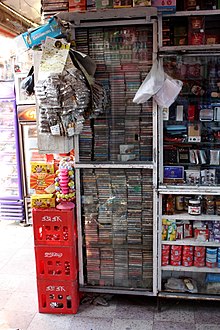
One of the political uses of cassette tapes was the dissemination of sermons by the exiled Ayatollah Khomeini throughout Iran before the 1979 Iranian Revolution, in which Khomeini urged the overthrow of the regime of the Shah, Mohammad Reza Pahlavi.[53] During the military dictatorship of Chile (1973–1990) a "cassette culture" emerged where blacklisted music or music that was by other reasons not available as records was shared.[54][55][56] Some pirate cassette producers created brands such as Cumbre y Cuatro that have in retrospect received praise for their contributions to popular music.[56] Armed groups such as Manuel Rodríguez Patriotic Front (FPMR) and the Revolutionary Left Movement (MIR) made use of cassettes to spread their messages.[55]
Cassette technology was a booming market for pop music in India, drawing criticism from conservatives while at the same time creating a huge market for legitimate recording companies, as well as pirated tapes.[57] Some sales channels were associated with cassettes: in Spain filling stations often featured a display selling cassettes. While offering also mainstream music these cassettes became associated with genres such as Gipsy rhumba, light music and joke tapes that were common in the 1970s and 1980s.[58]
Decline
[edit]Despite sales of CDs overtaking those of prerecorded cassettes in the early 1990s in the U.S.,[59] the format remained popular for specific applications, such as car audio, personal stereos, boomboxes, telephone answering machines, dictation, field recording, home recording, and mixtapes well into the decade. Cassette players were typically more resistant to shocks than CD players, and their lower fidelity was not considered a serious drawback in mobile use. With the introduction of electronic skip protection it became possible to use portable CD players on the go, and automotive CD players became viable. CD-R drives and media also became affordable for consumers around the same time.[60]
By 1993, annual shipments of CD players had reached 5 million, up 21% from the year before; while cassette player shipments had dropped 7% to approximately 3.4 million.[61] Sales of pre-recorded music cassettes in the US dropped from 442 million in 1990 to 274,000 by 2007.[62] For audiobooks, the final year that cassettes represented more than 50% of total market sales was 2002 when they were replaced by CDs as the dominant media.[63]
The last new car with an available cassette player was a 2014 TagAZ AQUiLA.[64] Four years prior, Sony had stopped the production of personal cassette players.[65] In 2011, the Oxford English Dictionary removed the phrase "cassette player" from its 12th edition Concise version,[66] which prompted some media sources to mistakenly report that the term "cassette tape" was being removed.[67]
In India, music continued to be released on the cassette format due to its low cost until 2009.[68]
21st century
[edit]
Although portable digital recorders are most common today, analog tape remains a desirable option for certain artists and consumers.[34][69] Underground and DIY communities release regularly, and sometimes exclusively, on cassette format, particularly in experimental music circles and to a lesser extent in hardcore punk, death metal, and black metal circles, out of a fondness for the format. Even among major-label stars, the form has at least one devotee: Thurston Moore stated in 2009, "I only listen to cassettes."[70] By 2019, few companies still made cassettes. Among those are National Audio Company, from the US, and Mulann, also known as Recording The Masters, from France.[71][72]
Sony announced the end of cassette Walkman production on 22 October 2010,[73] a result of the emergence of MP3 players such as Apple's iPod.[74] As of 2022, Sony uses the Walkman brand solely for its line of digital media players.[75]
In 2010, Botswana-based Diamond Studios announced plans[76] for establishing a plant to mass-produce cassettes in a bid to combat piracy. It opened in 2011.[77]
In South Korea, the early English education boom for toddlers encourages a continuous demand for English language cassettes, as of 2011,[update] due to the affordable cost.[78]
National Audio Company in Missouri, the largest of the few remaining manufacturers of audio cassettes in the US, oversaw the mass production of the "Awesome Mix #1" cassette from the film Guardians of the Galaxy in 2014.[79] They reported that they had produced more than 10 million tapes in 2014 and that sales were up 20 percent the following year, their best year since they opened in 1969.[80] In 2016, cassette sales in the United States rose by 74% to 129,000.[81] In 2018, following several years of shortage, National Audio Company began producing their own magnetic tape, becoming the world's first known manufacturer of an all-new tape stock.[82] Mulann, a company which acquired Pyral/RMGI in 2015 and originates from BASF, also started production of its new cassette tape stock in 2018, basing on reel tape formula.[83]
In Japan and South Korea, the pop acts Matsuda Seiko,[84] SHINee,[85] and NCT 127 released their material on limited-run cassettes.[86]
In the mid-to-late 2010s, cassette sales saw a modest resurgence concurrent with the vinyl revival. As early as 2015, the retail chain Urban Outfitters, which had long sold LPs, started selling new pre-recorded cassettes (both new and old albums), blank cassettes, and players.[87] In 2016, cassette sales increased,[88] a trend that continued in 2017[89] and 2018.[90] In the UK, sales of cassette tapes in 2021 reached its highest number since 2003.[91]
Cassettes are favored by some artists and listeners, including those of older genres of music such as dansband,[92] as well as independent[34] and underground artists,[93] some of whom were releasing new music on tape by the 2020s, including Britney Spears and Busta Rhymes.[94] Reasons cited for this include tradition, low cost,[34] the DIY ease of use,[95] and a nostalgic fondness for how the format's imperfections lend greater vibrancy to low-fi, experimental music, despite the lack of the "full-bodied richness" of vinyl.[34][93][95]
Tape types
[edit]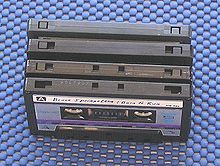
Cassette tapes are made of a polyester-type plastic film with a magnetic coating. The original magnetic material was based on gamma ferric oxide (Fe2O3). Circa 1970, 3M Company developed a cobalt volume-doping process combined with a double-coating technique to enhance overall tape output levels. This product was marketed as "High Energy" under its Scotch brand of recording tapes.[96] Inexpensive cassettes commonly are labeled "low-noise", but typically are not optimized for high frequency response. For this reason, some low-grade IEC Type I tapes have been marketed specifically as better suited for data storage than for sound recording.[citation needed]
In 1968,[97] DuPont, the inventor of a chromium dioxide (CrO2) manufacturing process, began commercialization of CrO2 media. The first CrO2 cassette was introduced in 1970 by Advent,[98] and later strongly backed by BASF, the inventor and longtime manufacturer of magnetic recording tape.[99] Next, coatings using magnetite (Fe3O4) such as TDK's Audua were produced in an attempt to approach or exceed the sound quality of vinyl records. Cobalt-adsorbed iron oxide (Avilyn) was introduced by TDK in 1974 and proved very successful. "Type IV" tapes using pure metal particles (as opposed to oxide formulations) were introduced in 1979 by 3M under the trade name Metafine. The tape coating on most cassettes sold as of 2024 are either "normal" or "chrome" consists of ferric oxide and cobalt mixed in varying ratios (and using various processes); there are very few cassettes on the market that use a pure (CrO2) coating.[30]
Simple voice recorders and earlier cassette decks are designed to work with standard ferric formulations. Newer tape decks usually are built with switches and later detectors for the different bias and equalization requirements for higher grade tapes. The most common are iron oxide tapes (defined by the IEC 60094 standard.[9]
Notches on top of the cassette shell indicate the type of tape. Type I cassettes have only write-protect notches, Type II have an additional pair next to the write protection ones, and Type IV (metal) have a third set near the middle of the top of the cassette shell. These allow later cassette decks to detect the tape type automatically and select the proper bias and equalization.[100]
Features
[edit]
The cassette was the next step following reel-to-reel audio tape recording, although, because of the limitations of the cassette's size and speed, it initially compared poorly in quality. Unlike the 4-track stereo open-reel format, the two stereo tracks of each side lie adjacent to each other, rather than being interleaved with the tracks of the other side. This permitted monaural cassette players to play stereo recordings "summed" as mono tracks and permitted stereo players to play mono recordings through both speakers. The tape is 0.15 in (3.81 mm) wide, with each mono track 1.5 millimetres (0.059 in) wide, plus an unrecorded guard band between each track. In stereo, each track is further divided into a left and a right channel of 0.6 mm (0.024 in) each, with a gap of 0.3 mm (0.012 in).[101] The tape moves past the playback head at 1+7⁄8 inches per second (4.76 cm/s), the speed being a continuation of the increasingly slower speed series in open-reel machines operating at 30, 15, 7+1⁄2, or 3+3⁄4 inches per second.[8] For comparison, the typical open-reel 1⁄4-inch 4-track consumer format used tape that is 0.248 inches (6.3 mm) wide, each track .043 in (1.1 mm) wide, and running at either twice or four times the speed of a cassette.[citation needed]
Very simple cassette recorders for dictation purposes did not tightly control tape speed and relied on playback on a similar device to maintain intelligible recordings. For accurate reproduction of music, a tape transport incorporating a capstan and pinch roller system was used, to ensure tape passed over the record/playback heads at a constant speed.
Locating write-protect notches
[edit]If the cassette is held with one of the labels facing the user and the tape opening at the bottom, the write-protect notch for the corresponding side is at the top-left.
Tape length
[edit]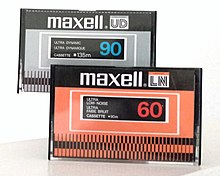
Tape length usually is measured in minutes of total playing time. Many of the varieties of blank tape were C60 (30 minutes per side), C90 (45 minutes per side) and C120 (60 minutes per side).[1] Maxell makes 150-minute cassettes (UR-150) - 75 minutes per side. The C46 and C60 lengths typically are 15 to 16 micrometers (0.59 to 0.63 mils) thick, but C90s are 10 to 11 μm (0.39 to 0.43 mils)[102] and (the less common) C120s are just 6 μm (0.24 mils) thick,[103] rendering them more susceptible to stretching or breakage. Even C180 tapes were available at one point.[104]
Other lengths are (or were) also available from some vendors, including C10, C12 and C15 (useful for saving data from early home computers and in telephone answering machines), C30, C40, C50, C54, C64, C70, C74, C80, C84, C94, C100, C105, C110, and C150. As late as 2010, Thomann still offered C10, C20, C30 and C40 IEC Type II tape cassettes for use with 4- and 8-track portastudios.[105]
Track width
[edit]The full tape width is 3.8 mm. For mono recording the track width is 1.5 mm. In stereo mode each channel has width of 0.6 mm with a 0.3 mm separation to avoid crosstalk.[106]
Head gap
[edit]The head-gap width[clarification needed] is 2 μm[according to whom?] which gives a theoretical maximum frequency[citation needed] of about 12 kHz (at the standard speed of 1 7/8 ips or 4.76 cm/s). A narrower gap would give a higher frequency limit but also weaker magnetization.[106]
Cassette tape adapter
[edit]Cassette tape adapters allow external audio sources to be played back from any tape player, but were typically used for car audio systems. An attached audio cable with a phone connector converts the electrical signals to be read by the tape head, while mechanical gears simulate reel to reel movement without actual tapes when driven by the player mechanism.[107]
Optional mechanical elements
[edit]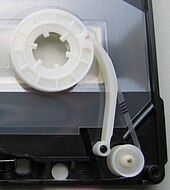
In order to wind up the tape more reliably, the former BASF (from 1998 EMTEC) patented the Special Mechanism or Security Mechanism advertised with the abbreviation SM in the early 1970s, which was temporarily used under license by Agfa. This feature each includes a rail to guide the tape to the spool and prevent an unclean roll from forming.[108]
Flaws
[edit]Magnetic tape is not an ideal medium for long-term archival storage, as it begins to degrade after 10 – 20 years, with some experts estimating its lifespan to be no more than 30 years.[109][110]
A common mechanical problem occurs when a defective player or resistance in the tape path causes insufficient tension on the take-up spool. This would cause the magnetic tape to be fed out through the bottom of the cassette and become tangled in the mechanism of the player. In these cases, the player was said to have "eaten" or "chewed" the tape, often destroying the playability of the cassette.[111][failed verification]
Cassette players and recorders
[edit]
The first cassette machines (e.g. the Philips EL 3300, introduced in August 1963[18][112])

One innovation was the front-loading arrangement. Pioneer's angled cassette bay and the exposed bays of some Sansui models eventually were standardized as a front-loading door into which a cassette would be loaded. Later models would adopt electronic buttons, and replace conventional meters (which could be "pegged" when overloaded[clarification needed]) with electronic LED or vacuum fluorescent displays, with level controls typically being controlled by either rotary controls or side-by-side sliders. BIC and Marantz briefly offered models that could be run at double speeds, but Nakamichi was widely recognized as one of the first companies to create decks that rivaled reel-to-reel decks with full 20–20,000 Hz frequency response, low noise, and very low wow and flutter.[113][114]
Different interpretations of the cassette standard resulted in a 4 dB ambiguity at 16 kHz. Technically, both camps in this debate were still within the original cassette specification as no tolerance for frequency response is provided above 12.5 kHz and all calibration tones above 12.5 kHz are considered optional.[115][116] Decreasing noise at 16 kHz also decreases the maximum signal level at 16 kHz, the High-Frequency Dynamics stay almost constant.[117]
A third company, Bang & Olufsen of Denmark, created the Dolby HX "head room extension" system for reliably reducing tape saturation effects at high frequencies while maintaining higher bias levels.[118]
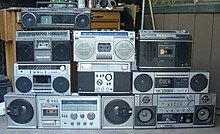
Applications for car stereos varied widely. Auto manufacturers in the US typically would fit a cassette slot into their standard large radio faceplates. Europe and Asia would standardize on DIN and double DIN sized faceplates. In the 1980s, a high-end installation would have a Dolby AM/FM cassette deck, and they rendered the 8-track player obsolete in car installations because of space, performance, and audio quality. In the 1990s and 2000s, as the cost of building CD players declined, many manufacturers offered a CD player. The CD player eventually supplanted the cassette deck as standard equipment, but some cars, especially those targeted at older drivers, were offered with the option of a cassette player, either by itself or sometimes in combination with a CD slot. Most new cars can still accommodate aftermarket cassette players, and the auxiliary jack advertised for MP3 players can be used also with portable cassette players, but 2011 was the first model year for which no manufacturer offered factory-installed cassette players.[119]

Applications
[edit]Audio
[edit]
The Compact Cassette originally was intended for use in dictation machines.[3] In this capacity, some later-model cassette-based dictation machines could also run the tape at half speed (15⁄16 in/s) as playback quality was not critical. The cassette soon became a medium for distributing prerecorded music—initially through the Philips Record Company (and subsidiary labels Mercury and Philips in the US). As of 2009, one still found cassettes used for a variety of purposes, such as journalism, oral history, meeting and interview transcripts, audio-books, and so on. Police are still big buyers of cassette tapes, as some lawyers "don't trust digital technology for interviews".[120] However, they are starting to give way to Compact Discs and more "compact" digital storage media. Prerecorded cassettes were also employed as a way of providing chemotherapy information to recently diagnosed cancer patients as studies found anxiety and fear often gets in the way of the information processing.[121]
The cassette quickly found use in the commercial music industry. One artifact found on some commercially produced music cassettes was a sequence of test tones, called SDR (Super Dynamic Range, also called XDR, or eXtended Dynamic Range) soundburst tones, at the beginning and end of the tape, heard in order of low frequency to high. These were used during SDR/XDR's duplication process to gauge the quality of the tape medium. Many consumers objected to these tones since they were not part of the recorded music.[122]
Home studio
[edit]In the simplest configuration, rather than playing a pair of stereo channels of each side of the cassette, the typical "portastudio" used a four-track tape head assembly to access four tracks on the cassette at once (with the tape playing in one direction). Each track could be recorded to, erased, or played back individually, allowing musicians to overdub themselves and create simple multitrack recordings easily, which could then be mixed down to a finished stereo version on an external machine. To increase audio quality in these recorders, the tape speed sometimes was doubled to 33/4 inches per second, in comparison to the standard 17⁄8 ips; additionally, dbx, Dolby B or Dolby C noise reduction provided compansion (compression of the signal during recording with equal and opposite expansion of the signal during playback), which yields increased dynamic range by lowering the noise level and increasing the maximum signal level before distortion occurs. Multi-track cassette recorders with built-in mixer and signal routing features ranged from easy-to-use beginner units up to professional-level recording systems.[123]
Home dubbing
[edit]
Most cassettes were sold blank, and used for recording (dubbing) the owner's records (as backup, to play in the car, or to make mixtape compilations), their friends' records, or music from the radio. This practice was condemned by the music industry with such alarmist slogans as "Home Taping Is Killing Music". However, many claimed that the medium was ideal for spreading new music and would increase sales, and strongly defended their right to copy at least their own records onto tape. For a limited time in the early 1980s Island Records sold chromium dioxide "One Plus One"[124]
Various legal cases arose surrounding the dubbing of cassettes. In the UK, in the case of CBS Songs v. Amstrad (1988), the House of Lords found in favor of Amstrad that producing equipment that facilitated the dubbing of cassettes, in this case a high-speed twin cassette deck that allowed one cassette to be copied directly onto another, did not constitute copyright infringement by the manufacturer.[125] In a similar case, a shop owner who rented cassettes and sold blank tapes was not liable for copyright infringement even though it was clear that his customers likely were dubbing them at home.[126] In both cases, the courts held that manufacturers and retailers could not be held accountable for the actions of consumers.[127]
As an alternative to home dubbing, in the late 1980s, the Personics company installed booths in record stores across America that allowed customers to make personalized mixtapes from a digitally encoded back-catalogue with customised printed covers.[128]
Data recording
[edit]
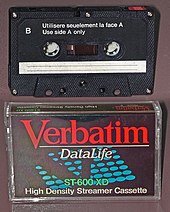
Floppy disk storage had become the standard data storage medium in the United States by the mid-1980s; for example, by 1983 the majority of software sold by Atari Program Exchange was on floppy. Cassette remained more popular for 8-bit computers such as the Commodore 64, ZX Spectrum, MSX, and Amstrad CPC 464 in many countries such as the United Kingdom[129][130] (where 8-bit software was mostly sold on cassette until that market disappeared altogether in the early 1990s). Reliability of cassettes for data storage is inconsistent, with many users recalling repeated attempts to load video games;[131] the Commodore Datasette used very reliable, but slow, digital encoding.[132] In some countries, including the United Kingdom, Poland, Hungary, and the Netherlands, cassette data storage was so popular that some radio stations would broadcast computer programs that listeners could record onto cassette and then load into their computer.[133][134] See BASICODE.
The cassette was adapted into what is called a streamer cassette (also known as a "D/CAS" cassette), a version dedicated solely for data storage, and used chiefly for hard disk backups and other types of data. Streamer cassettes look almost exactly the same as a standard cassette, with the exception of having a notch about one quarter-inch wide and deep situated slightly off-center at the top edge of the cassette. Streamer cassettes also have a re-usable write-protect tab on only one side of the top edge of the cassette, with the other side of the top edge having either only an open rectangular hole, or no hole at all. This is due to the entire one-eighth inch width of the tape loaded inside being used by a streamer cassette drive for the writing and reading of data, hence only one side of the cassette being used. Streamer cassettes can hold anywhere from 250 kilobytes to 600 megabytes of data.[135]
Rivals and successors
[edit]
Technical development of the cassette effectively ceased when digital recordable media, such as DAT and MiniDisc, were introduced in the late 1980s and early-to-mid 1990s, with Dolby S recorders marking the peak of Compact Cassette technology. Anticipating the switch from analog to digital format, major companies, such as Sony, shifted their focus to new media.[136] In 1992, Philips introduced the Digital Compact Cassette (DCC), a DAT-like tape in almost the same shell as a Compact Cassette. It was aimed primarily at the consumer market. A DCC deck could play back both types of cassettes. Unlike DAT, which was accepted in professional usage because it could record without lossy compression effects, DCC failed in home, mobile and professional environments, and was discontinued in 1996.[137]

The microcassette largely supplanted the full-sized cassette in situations where voice-level fidelity is all that is required, such as in dictation machines and answering machines. Microcassettes have in turn given way to digital recorders of various descriptions.[138] Since the rise of cheap CD-R discs, and flash memory-based digital audio players, the phenomenon of "home taping" has effectively switched to recording to a Compact Disc or downloading from commercial or music-sharing websites.[139]
Because of consumer demand, the cassette has remained influential on design, more than a decade after its decline as a media mainstay. As the Compact Disc grew in popularity, cassette-shaped audio adapters were developed to provide an economical and clear way to obtain CD functionality in vehicles equipped with cassette decks but no CD player. A portable CD player would have its analog line-out connected to the adapter, which in turn fed the signal to the head of the cassette deck. These adapters continue to function with MP3 players and smartphones, and generally are more reliable than the FM transmitters that must be used to adapt CD players and digital audio players to car stereo systems. Digital audio players shaped as cassettes have also become available, which can be inserted into any cassette player and communicate with the head as if they were normal cassettes.[140][141]
See also
[edit]- Compact Video Cassette
- Digital cassettes
- Digital journalism
- J-card
- Mini-Cassette
- Personal stereo
- Pocket Rockers
- Picocassette
- Timeline of audio formats
- VHS
- Video 2000
Further reading
[edit]- Marc Masters. 2023. High Bias: The Distorted History of the Cassette Tape. University of North Carolina Press.
References
[edit]- ^ a b "Museum Of Obsolete Media". 19 November 2015. Archived from the original on 3 May 2016. Retrieved 29 April 2016.
- ^ Mark Pernice (23 December 2015). "Opinion: Our Misplaced Nostalgia for Cassette Tapes". New York Times. Retrieved 17 June 2024.
- ^ a b c Dormon, Bob (30 August 2013). "Are You for Reel? How the Compact Cassette Struck a Chord for Millions". The Register. Archived from the original on 2 August 2020. Retrieved 6 August 2022.
- ^ "Learn about Tabs-In or Tabs-Out Shells and Leaders". nationalaudiocompany.com. Archived from the original on 9 August 2017. Retrieved 9 August 2017.
- ^ "How to Identify Your Audio Cassette Tape Formats". digitalcopycat.com. Retrieved 13 September 2022.
- ^ Brian, Marshall (April 2000). "How Tape Recorders Work". HowStuffWorks. Retrieved 10 October 2015.
- ^ "Car Cartridges Come Home", pp.18-22, HiFi / Stereo Review's Tape Recorder Annual 1968, retrieved 22 May 2023. (Detailed diagram of a Fidelipac cartridge on p.20, with comparison to Lear Jet 8-track cartridge and Phillips cassette diagrams on p.21; extensive expert discussion of cassette, and comparisons to competitors, on pp.21-22.)
- ^ a b "D NORMAL-BIAS AUDIO TAPES" (PDF) (spec sheet). TDK. Archived from the original (PDF) on 20 June 2007. Retrieved 4 April 2019.
- ^ a b "Part 7: Cassette for commercial tape records and domestic use". International standard IEC 60094-7: Magnetic tape sound recording and reproducing systems. International Electrotechnical Commission, Geneva.
- ^ "Brew Disk-To-Tape Revolution". Variety. 16 September 1953. p. 1. Retrieved 6 October 2019.
- ^ "videointerchange.com". videointerchange.com. 7 August 2010. Retrieved 20 August 2010.
- ^ "dianaschnuth.com". Blog.dianaschnuth.com. Retrieved 20 August 2010.
- ^ Radio Elektronik Schau (in German). Vol. 41. 1965.
- ^ Daniel et al, p.102-4.
- ^ David Morton, Sound recording: the life story of a technology. Greenwood Publishing Group, 2004, p.161.
- ^ John Shepherd, Continuum Encyclopedia of Popular Music of the World. Continuum International Publishing Group, 2003, p.506
- ^ "Cassette Rampage Forecast". Billboard. Vol. 79, no. 44. Nielsen Business Media, Inc. 4 November 1967. pp. 1, 72. ISSN 0006-2510.
- ^ a b "European Mfrs. Bid for Market Share". Billboard. Vol. 79, no. 14. Nielsen Business Media, Inc. 8 April 1967. p. 18. ISSN 0006-2510.
- ^ Jan Drees, Christian Vorbau, Kassettendeck: Soundtrack einer Generation. Klappenbroschur, 2011Drees, Jan; Vorbau, Christian (23 May 2011). Kassettendeck: Soundtrack einer Generation. Eichborn Verlag. ISBN 978-3821866147.
- ^ a b c d e f g h Millard, Andre (2013). "Cassette Tape". St. James Encyclopedia of Popular Culture (2.1 ed.). p. 529.
- ^ [3][14][15][16][17][18][19][20]
- ^ Rothman, Lily. "Rewound: On its 50th birthday, the cassette tape is still rolling". Time. Archived from the original on 2 August 2013. Retrieved 6 August 2013.
- ^ "Gouden jubileum muziekcassette". NOS. 30 August 2013. Retrieved 30 December 2013.
- ^ "Compact Cassette supremo Lou Ottens talks to El Reg". 2 September 2013. Retrieved 9 April 2020.
- ^ a b Hans-Joachim Braun, Music and technology in the twentieth century. JHU Press, 2002, p.161.
- ^ The Dolby stretcher — new boon for tape (PDF). Tape Recording ##11-12, 1970. p. 11.
- ^ "Grundig C 100 and the early history of the Compact Cassette". 7 March 2016.
- ^ Nathan, John (1999). Sony: The Private Life. Houghton Mifflin. p. 129.
- ^ Nathan, John (1999). Sony: the Private Life. Houghton Mifflin. p. 129. ISBN 978-0618126941. Retrieved 8 November 2015.
- ^ a b c d Eric D. Daniel; C. Dennis Mee; Mark H. Clark (1999). Magnetic Recording: The First 100 Years. The Institute of Electrical and Electronics Engineers. ISBN 978-0-7803-4709-0.
- ^ The Dolby stretcher — new boon for tape (PDF). Tape Recording ##11-12, 1970. p. 11.
- ^ "Mercury Issues 49 'Cassettes'". Billboard. Vol. 78, no. 29. Nielsen Business Media, Inc. 16 July 1966. p. 69. ISSN 0006-2510.
- ^ Marvin Camras, ed. (1985). Magnetic Tape Recording. Van Nostrand Reinhold. ISBN 978-0-442-21774-7.
- ^ a b c d e Lynskey, Dorian (29 March 2010). "Return of the audio cassette". The Guardian. Retrieved 14 August 2023.
- ^ "40 years ago, the Sony Walkman changed how we listen to music". The Verge. July 2019. Retrieved 14 August 2023.
- ^ a b c "The first Sony Walkman goes on sale". History.com. Retrieved 14 August 2023.
- ^ Hoogendoorn, A (1994). "Digital Compact Cassette". Proceedings of the IEEE. 82 (10): 1479–1489. doi:10.1109/5.326405.
- ^ a b Paul du Gay; Stuart Hall; Linda Janes; Hugh Mackay; Keith Negus (1997). Doing Cultural Studies: The Story of the Sony Walkman. Sage Publications Ltd. ISBN 978-0-7619-5402-6.
- ^ a b Gans, David (June 1983). "Packaging Innovations Raise Cassettes' In-store Profile". Record. 2 (8): 20.
- ^ Andriessen, Willem (1999). ""THE WINNER": Compact Cassette. A Commercial and Technological Look Back at the Greatest Success Story in the History of Audio Up to Now". Journal of Magnetism and Magnetic Materials. 193 (1–3): 12. doi:10.1016/s0304-8853(98)00502-2.
- ^ Palmer, Robert (29 July 1981). "The Pop Life; Cassettes Now Have Material Not Available On Disks". The New York Times. Retrieved 27 April 2021.
- ^ "Total rewind: 10 key moments in the life of the cassette". The Guardian. 30 August 2013. Retrieved 14 August 2023.
- ^ "As Apple kills off the iPod ... here are 5 other pieces of beloved tech we've said goodbye to in the past 20 years". We Forum. 16 August 2017. Retrieved 14 August 2023.
- ^ "'Walkman' has become generic, rules Supreme Court". World Trademark Review. Retrieved 14 August 2023.
- ^ "Sony loses Walkman trade mark as too generic". Pinsent Masons. 5 June 2002. Retrieved 12 August 2023.
- ^ "Rewind! A guide to the best portable cassette players". The Vinyl Factory. 24 March 2017. Retrieved 14 August 2023.
- ^ "In a digital age, vinyl's making a comeback". Los Angeles Times. 26 April 2009. Retrieved 14 August 2023.
- ^ "Not long left for cassette tapes". BBC. 17 June 2005. Retrieved 13 September 2006.
- ^ Jude Rogers (30 August 2013). "Total rewind: 10 key moments in the life of the cassette". The Guardian. Retrieved 17 March 2014.
- ^ Robin James (1992). Cassette Mythos. Brooklyn, NY: Autonomedia. ISBN 978-0-936756-69-1.
- ^ Simon, Andrew (2022). Media of the Masses: Cassette Culture in Modern Egypt. Stanford: Stanford University Press. ISBN 978-1-5036-2943-1.
- ^ Media of the Masses: Cassette Culture in Modern Egypt. Stanford University Press. 2022. ISBN 9781503629431.
- ^ S. Alexander Reed (2013). Assimilate: A Critical History of Industrial Music. Oxford University Press. p. 113. ISBN 978-0199832606.
- ^ Jordán González, Laura (2019). "Chile: Modern and Contemporary Performance Practice". In Sturman, Janet (ed.). The SAGE International Encyclopedia of Music and Culture. SAGE Publications. pp. 509–511. ISBN 978-1-4833-1775-5.
- ^ a b Jordán, Laura (2009). "Música y clandestinidad en dictadura: la represión, la circulación de músicas de resistencia y el casete clandestino" [Music and "clandestinidad" During the Time of the Chilean Dictatorship: Repression and the Circulation of Music of Resistance and Clandestine Cassettes]. Revista Musical Chilena (in Spanish). 63 (Julio–Diciembre): 212. doi:10.4067/S0716-27902009000200006.
- ^ a b Montoya Arias, Luis Omar; Díaz Güemez, Marco Aurelio (12 September 2017). "Etnografía de la música mexicana en Chile: Estudio de caso". Revista Electrónica de Divulgación de la Investigación (in Spanish). 14: 1–20.
- ^ Peter Manuel (1993). Cassette Culture: Popular Music and Technology in North India. University of Chicago Press. ISBN 978-0-226-50401-8.
- ^ Arenas, Guillermo (16 August 2019). "Las cintas de casete pasan de la gasolinera a la Biblioteca Nacional". El País (in Spanish). Retrieved 23 May 2020.
- ^ "U.S. Sales Database". RIAA. Retrieved 19 October 2022.
- ^ "1995: Consumer CD-R Drive Priced Below $1000". Computer History Museum. Retrieved 23 January 2022.
- ^ "Record and prerecorded tape stores". Gale Encyclopedia of American Industries. 2005. Retrieved 20 September 2006.
- ^ "Tape Echo: Specialty labels keep cassettes alive". Billboard. 11 October 2008. Archived from the original on 25 February 2009.
- ^ Audio Publishers Association Fact Sheet Archived 26 October 2010 at the Wayback Machine (also includes some historical perspective in the 1950s by Marianne Roney)
- ^ "Tagaz Aquila". Wroom.ru (in Russian). Retrieved 26 January 2021.
- ^ "Sony kills the cassette Walkman on the iPod's birthday". 23 October 2010. Retrieved 19 October 2020.
- ^ Shea, Ammon (10 November 2011). "Reports of the death of the cassette tape are greatly exaggerated". Oxford English Dictionary. Archived from the original on 12 May 2015. Retrieved 28 January 2015.
- ^ Moye, David (22 August 2011). "Oxford Dictionary Removes 'Cassette Tape,' Gets Sound Lashing From Audiophiles". Huffington Post.
- ^ Kohli-Khandekar, Vanita (2013). The Indian Media Business (4 ed.). New Delhi: Sage India. pp. 184–90. ISBN 9788132118015. Retrieved 26 July 2022 – via Google Books.
- ^ Segal, Dave (9 March 2016). "Baby, I'm for Reel: Unspooling the Affordable, Accessible Microeconomy of the Cassette Revival". The Stranger. Retrieved 11 March 2016.
- ^ "Articles: This Is Not a Mixtape". Pitchfork. 22 February 2010. Archived from the original on 4 March 2016. Retrieved 20 August 2010.
- ^ "French firm opens factory making first cassettes since 1990s after artists like Taylor Swift go retro". 22 March 2019. Retrieved 22 November 2021.
- ^ "National Audio Company now has a cassette-making competitor. They're in France".
- ^ "End Of An Era: Sony Stops Manufacturing Cassette Walkmans". Tech Crunch. 22 October 2010. Retrieved 14 August 2023.
- ^ "Original Walkman is RiP (replaced by iPod)". 26 October 2010. Retrieved 14 August 2023.
- ^ "Do You Still Love the Walkman?". The New York Times. 10 March 2022. Retrieved 14 August 2023.
- ^ Butaumocho, Ruth (19 April 2010). "Zimbabwe: Diamond Studios to Commission Cassette Plant". Retrieved 1 January 2017 – via AllAfrica.
- ^ Curnow, Robyn (7 June 2011). "Pause and Rewind: Zimbabwe's Audio Cassette Boom". CNN. Retrieved 13 July 2011.
- ^ Choi (최), Yeon-jin (연진) (31 May 2011). 멸종 중인 카세트, 한국선 '장수 만세. Hankook Ilbo (in Korean). Archived from the original on 14 August 2011. Retrieved 13 July 2011.
- ^ "Meet The Owner Of America's Last Awesome Cassette Tape Factory". Slant. Archived from the original on 19 April 2016. Retrieved 4 June 2017.
- ^ Jeniece Pettitt (1 September 2015). "This Company Is Still Making Audio Cassettes and Sales Are Better Than Ever". Bloomberg.com. Retrieved 9 September 2015.
- ^ "U.S. Cassette Album Sales Increased by 74% in 2016, Led by 'Guardians' Soundtrack". Billboard. 21 January 2017.
- ^ "The world was running out of cassette tape. Now it's being made in Springfield". Springfield News-Leader. 7 January 2018. Retrieved 24 April 2018.
- ^ "Audio cassettes are produced again!". Mulann S.A. 11 October 2018. Archived from the original on 27 July 2020. Retrieved 6 May 2020.
- ^ "Eien no Motto Hate Made / Wakusei ni Naritai [Cassette Tape] [Limited Edition / Type C]". CDJapan., CD Japan. Retrieved 13 June 2018
- ^ "SHINee Vol. 5 - 1 of 1 (Cassette Tape Limited Edition)"., YesAsia. Retrieved 13 June 2018
- ^ "【カセットテープ】 Chain [スマプラ付]<初回生産限定盤>]"., Tower Records Japan. Retrieved 13 June 2018
- ^ "Cassettes". Archived from the original on 27 November 2015. Retrieved 30 July 2016.
- ^ "Cassette sales increased by 74% in 2016". 23 January 2017. The Vinyl Factory. Retrieved 26 October 2018
- ^ "Cassette sales grew 35% in 2017". 5 January 2018. The Vinyl Factory. Retrieved 26 October 2018
- ^ "UK cassette sales grew by 90% in first half of 2018". 26 July 2018. The Vinyl Factory. Retrieved 26 October 2018
- ^ "Let's get physical: new BPI report shows vinyl & cassettes sales surge, decline of the CD slows". MusicWeek.com. Retrieved 14 September 2022.
- ^ "Vad händer med dansbandsutgivningen när Bert säljer?". Archived from the original on 20 August 2010. Retrieved 14 August 2023.
- ^ a b "This Is Not a Mixtape". Pitchfork. 22 February 2010. Retrieved 14 August 2023.
- ^ "Popular/Major Releases on Cassette [2021 NEW]". Discogs. Retrieved 14 August 2023.
- ^ a b "Baby, I'm for Reel: Unspooling the Affordable, Accessible Microeconomy of the Cassette Revival". TheStranger. Retrieved 14 August 2023.
- ^ "History of Compact Cassette". Retrieved 4 June 2012.
- ^ Canby, Tatnall (1968). "CrO2 - Tomorrow's Tape". Studio Sound (5): 239.
- ^ Stark, Craig (1992). "Choosing the Right Tape". Stereo Review (March): 45–48.
- ^ Werner Abelshauser; Wolfgang von Hippel; Jeffrey Allan Johnson; Raymond G. Stokes (2003). German Industry and Global Enterprise: BASF: The History of a Company. Cambridge University Press. p. 585. ISBN 978-0-521-82726-3.
- ^ "Which Type of Audio Cassette Tape is Right for You : Type 1, 2 or 4 ? - Cassette Player Culture". cassette-player.com. Archived from the original on 2 July 2024. Retrieved 2 July 2024.
- ^ van der Lely, P.; Missriegler, G. (1970). "Audio tape cassettes" (PDF). Philips Technical Review. 31 (3): 85. Archived from the original (PDF) on 10 November 2018. Retrieved 3 September 2018.
- ^ "Audio tape length and thickness". en.wikiaudio.org. Archived from the original on 17 March 2018. Retrieved 16 March 2018.
- ^ "NAC Audio Cassette Glossary – Cassetro". nactape.com. Archived from the original on 16 March 2018. Retrieved 16 March 2018.
- ^ "VintageCassettes.com". Retrieved 26 September 2011.
- ^ "Compact Cassettes". Thomann U.K. International Cyperstore. Archived from the original on 11 August 2010. Retrieved 22 October 2010.
- ^ a b "Happy 50th birthday, Compact Cassette: How it struck a chord for millions". The Register. 30 August 2013. p. 2. Retrieved 29 April 2016.
In a mono arrangement, each track is 1.5mm per side across the 3.8mm tape width. For stereo, the left and right tracks are only 0.6mm apiece, with 0.3mm separation to avoid crosstalk.
- ^ Cassette adapters are remarkably simple
- ^ Patent EP 0078997 A2 – Bandkassette mit einem Aufzeichnungsträger mit Magnetspur und Echolöscheinrichtungen für solche Bandkassetten, eingetragen am 28. Oktober 1982
- ^ Pogue, David (1 September 2016). "Digitize Those Memory-Filled Cassettes before They Disintegrate". Scientific American. Archived from the original on 12 August 2023. Retrieved 12 August 2023.
- ^ Somerfield, Katy. "History of the Cassette Tape". Legacy Box. Archived from the original on 12 August 2023. Retrieved 12 August 2023.
- ^ Fluker, Steve. "Trends in Technology: Recording Sound". Archived from the original on 23 September 2004.
- ^ "Philips Compact Cassette". Philips Museum. Archived from the original on 11 July 2010. Retrieved 20 August 2010.
- ^ John Atkinson (November 2002). "40 years of Stereophile: The Hot 100 Products". Retrieved 13 September 2006.
- ^ David Price (January 2000). "Olde Worlde – Nakamichi CR-7E Cassette Deck". Archived from the original on 21 August 2006. Retrieved 13 September 2006.
- ^ Hess, Richard (May 2006). "Cassette Equalization: The 4 dB ambiguity at 16 kHz". Retrieved 16 October 2012.
- ^ Hess, Richard (October 2010). "Cassette equalization redo". Retrieved 16 October 2012.
- ^ Klingelnberg, Arndt (May 1979). "HiFi-Stereophonie". Aussteuerungsprobleme.
- ^ Arndt Klingelnberg (1990 March) AES No. 2912 Some Not Well Known Aspects of Analog Tape concerning dynamic bias (Dolby HX-PRO)
- ^ Williams, Stephen (4 February 2011). "For Car Cassette Decks, Play Time Is Over". New York Times. Retrieved 18 July 2012.
- ^ "Demand actually increasing for cassette tapes". AfterDawn. 18 May 2009. Retrieved 25 February 2014.
- ^ Aston, Val. "Chemotherapy Information for Patients and their Families: Audio Cassettes, a New Way Forward". European Journal of Oncology Nursing. 2.1 (1998): 67-8.
- ^ "Analysis of an SDR Cassette Tape". April 2009.
- ^ "VintageCassette.com". Archived from the original on 2 September 2006. Retrieved 13 September 2006.
- ^ "Island Records launched 'One Plus One' cassettes". Rock History. 13 February 2013. Retrieved 4 April 2013.
- ^ CBS Songs v. Amstrad (1988)
- ^ CBS v. Ames (1982)
- ^ Dubey, N. B. (December 2009). Office Management: Developing Skills for Smooth Functioning. Global India Publications. ISBN 978-93-80228-16-7.
- ^ Chiu, David (26 October 2016). "The Forgotten Precursor to iTunes". Pitchfork. Retrieved 21 June 2020.
- ^ Pountain, Dick (January 1985). "The Amstrad CPC 464". Byte. p. 401. Retrieved 27 October 2013.
- ^ DeWitt, Robert (June 1983). "APX / On top of the heap". Antic. Retrieved 30 October 2013.
- ^ Crookes, David (26 January 2011). "Gadgets: Rage against the machine". The Independent. London. Retrieved 31 January 2012.
Many will recall fiddling around with volume controls on their computer cassette decks in the hope that Manic Miner would actually load and not crash after 30 minutes of listening to beeps and crackles. ... 'I remember listening to Elite load on the BBC Micro for half an hour, only for it to continually fail at 98 per cent complete,' recalls Luke Peters, editor of T3 magazine.
- ^ De Ceukelaire, Harrie (February 1985). "How TurboTape Works". Compute!. p. 112. Retrieved 30 October 2013.
- ^ Lennart Benschop. "BASICODE". Retrieved 20 January 2008.
- ^ "Mixtape: Cassetternet". WNYC Studios. 12 November 2021. Archived from the original on 12 November 2021. Retrieved 24 December 2021.
- ^ "Streamer Cassette (D/CAS) (late 1980s – late 1990s)". Museum of Obsolete Media. 2019. Retrieved 19 July 2019.
- ^ Al Fasoldt (1991). "Sony Unveils the Minidisc". The Syracuse Newspapers. Archived from the original on 23 August 2009.
- ^ Gijs Moes (31 October 1996). "Successor of cassette failed: Philips stops production of DCC". Eindhovens Dagblad.
- ^ "Cassette vs. Digital". J&R Product Guide. Archived from the original on 28 September 2007.
- ^ "Phonograph records and prerecorded audio tapes and disks". Gale Encyclopedia of American Industries. 2005. Retrieved 20 September 2006.
- ^ Jer Davis (2000). "The Rome MP3: Portable MP3 player—with a twist". The Tech Report. Archived from the original on 13 August 2006. Retrieved 18 September 2006. (Internet Archive link)
- ^ "C@MP CP-UF32/64 a New Portable Mp3-Player Review". Fastsite. 2000. Archived from the original on 14 September 2010. Retrieved 18 September 2006.
External links
[edit]- Project C-90, a website dedicated to cassette tapes
- tapedeck.org, an online collection of blank audio tape cassettes
Physical audio recording formats | |||||||||||||||||||||||
|---|---|---|---|---|---|---|---|---|---|---|---|---|---|---|---|---|---|---|---|---|---|---|---|
| Mechanical |
| ||||||||||||||||||||||
| Analog |
| ||||||||||||||||||||||
| Analog-to-digital converter |
| ||||||||||||||||||||||
| Digital |
| ||||||||||||||||||||||
| Hybrid |
| ||||||||||||||||||||||
Magnetic-tape data storage formats | |||||||||||||
|---|---|---|---|---|---|---|---|---|---|---|---|---|---|
| Linear |
| ||||||||||||
| Helical |
| ||||||||||||
| Music technology | |
|---|---|
| Sound recording | |
| Recording media | |
| Analog recording | |
| Playback transducers | |
| Digital audio | |
| Live music | |
| Electronic music | |
| Software | |
| Professions | |
| People and organizations | |
| Related topics | |
| Divisions and subsidiaries |
| ||||
|---|---|---|---|---|---|
| Joint ventures and shareholdings |
| ||||
| Brands, products and standards |
| ||||
| People | |||||
| Places | |||||
| Related topics | |||||

